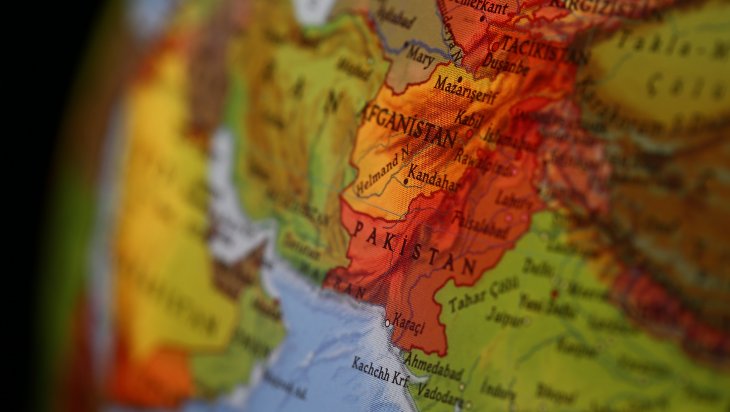Can Pakistan act as facilitator in the Iran-Saudi Arabia rapprochement?

Mohammad Pervez Bilgrami
Saudi Arabia and Iran, the two prominent regional powers with conflicting ideological interests, have been at loggerheads since they severed formal diplomatic relations a few years ago. The four-decades-long rivalry has followed the predictable pattern of tension and détente. Both countries, seemingly disillusioned with the futility of their ravaging conflicts, are now looking for acceptable mediation as the severing of diplomatic ties and jingoism has not yielded any substantially useful results. They have now realised that not speaking at the diplomatic level is providing leverage to other actors with vested interests in the region. The United Arab Emirates (UAE) has initiated a rapprochement with Iran by sending its officials to Tehran. Russia, China and Turkey in the region are advancing more in tandem to de-escalate the conflict.
Moreover, the Saudi war in Yemen is becoming a liability with the US reluctance to be part of Saudi military adventure. At the same time, Iran has managed to get the Russian military involvement in Syria and Libya. The relations between Saudi Arabia and Iran have reached a dead end where the revision of their strategies is the only option, this working through mediation.
Complicated Saudi-Iran relations
Both Saudi Arabia and Iran are major petroleum exporting countries with a competition for markets across the world. Since the 1979 Revolution, Iran too started asserting its leadership claims over the Islamic world, something that was previously solely reserved for Saudis for them being the custodian of two holy mosques. The Iranian offensive to export its revolution to the neighbouring Gulf countries and the Iran-Iraq war since the 1980s have cast a shadow on their relations. Iran has been successful in wielding significant influence in Syria, Lebanon, Iraq, Afghanistan and Yemen.
A brief détente was brought in in 1990s by the thenIranian president Hashemi Rafsanjani, and Saudi Arabian Crown Prince Abdullah Bin Abdul Aziz who met on the side-lines of the 1991 OIC Summit in Senegal. A Comprehensive Cooperation Agreement was signed between them in 1998, and in 2001 the two countries signed a bilateral security agreement. Yet this détente was reversed by dramatic expansion of Iran in post-war Iraq and post-uprising Syria where Iranians and their Shia militias have set a strong foothold, at the cost of a humanitarian catastrophe of staggering proportions inflicted on mostly Sunni Muslim population.
The Saudis responded with quick military intervention in Yemen when the Iran-backed Houthi militias overturned a UN brokered constitutional transition in 2015. The intervention under the pretext of protecting the UN-recognised government of Mansour Hadi, failed pushing the Houthi militia for a compromise and rather Saudi-led military coalition was caught in stalemate. At the same time, both Saudi Arabia and the United Arab Emirates saw the Arab-spring anti-government protests as a threat to their leadership and started supporting the counter-revolutionary forces across the region. The July 3, 2013 military coup in Egypt, the rise of General Khalifa Haftar in Libya, and supporting pro-Saudi politicians and military generals in Tunisia and Sudan and then reaching out to pro-Saudi Shias in Iraq have relatively strengthened Saudi power in the region.
The short-lived progress in Saudi-Iranian bilateral relations during the presidency of Mahmoud Ahmadinejad, when he paid state visits to Saudi Arabia in 2007 and 2012, came to an end after Saudi Arabia found Iran fuelling anti-regime protests in Bahrain and encouraging the Houthis to reverse the UN-led transition in Yemen in 2014. The eventual Houthi takeover of Sana in 2015 and the subsequent Saudi coalition’s military intervention against the Houthis brought the two sides to an irreversible diplomatic crisis. The Saudi-embassy was set on fire in Tehran after a prominent Saudi Shia leader Sheikh Nimr al-Nimr was executed in 2016 after being convicted on terrorism charges. The September 13, 2019 drone attack on a Saudi Aramco facility and subsequent attack on an Iranian oil tanker in the Red Sea have sent worrying signals concerning the stability of the Gulf region.
The Energy rivalry
Apart from politics, the Saudi – Iranian rivalry has also stretched into the economic realm. Both countries are key members of the Organisation of Petroleum Exporting Countries (OPEC), and have often taken diametrically opposed positions over energy policy. Saudi Arabia, with its large oil reserves and smaller population, has a greater interest in taking a long-term view of the global oil market and prefers the oil prices to remain at a moderate level. In contrast, Iran is compelled to focus on high prices in the short term as its sanction-hit oil facilities are ageing and outmoded. Iran’s oil exploration cost is higher and its population is almost three times that of Saudi Arabia, unable to reach the level of oil production (6.6mbpd) in pre-revolution years, Iran’s oil production in 2018 was (4.46 mbpd). Meanwhile, Saudi oil production is now nearly triple (12.42 mbpd) that of Iran’s peak output. In October IMF had sharply cut the Iran and Saudi growth forecast.
Though the Saudi Economy is not doing good and is expected to remain stagnant in 2019, Iran’s sanction-hit economy, which is heavily reliant on oil revenues, is hit by High inflation, huge youth unemployment, plummeting currency, and economic contraction thus painting a bleak picture and compelling Iran to come to the negotiation table. The normalisation may also help Pakistan secure its easy and low-cost access to meeting its skyrocketing energy demands from neighbouring Iran and may in the process pave the way for the resumption of Iran-Pakistan-India pipeline.
Why Pakistan?
The Pakistani leadership has been vocal in the past about his country’s constructive role in mediating between Iran and Saudi Arabia. In 2016, he had opposed Pakistan’s involvement in the Saudi coalition to dislodge Iran-backed Houthi militia from Yemen’s Aden. He had even held separate meetings with the ambassadors of Saudi Arabia and Iran back then. Being the only Muslim nuclear state, Pakistan aspires to play a leading role in resolving the Iran-Saudi Arabia conflict. Since Imran Khan came to power, Pakistan’s relations with Saudi Arabia and Iran have been one of the biggest talking points in the Gulf circles. Saudi Arabia has deep-rooted civil as well as strategic relations with Pakistan, and helped Pakistan many a time when the latter’s economy was in trouble. Besides, Pakistan’s nuclear programme was reported to have allegedly been financially supported by Saudi Arabia.
Pakistan’s Prime Minster, Imran Khan, recently travelled to Saudi Arabia and Iran to initiate mediation between the two countries. It is reported that the US president, Donald Trump, on the side-lines of the 74th UN General Assembly Session, had asked Imran Khan to play a role in defusing tensions between Riyadh and Tehran. Unlike Saudi Arabia and Iran, Pakistan, being a new Sunni Muslim state established by a modern Muslim constitution, maintains a non-sectarian Islamic identity since its establishment in 1947. Moreover, with Pakistan being the only Muslim nuclear power, both Iran and Saudi Arabia have tried to maintain good relations with the country. Both Iran and Saudi Arabia have reasons to accept Pakistan as a neutral mediator and trust on its good offices to reduce tension in the region. Pakistan, too, needs an immediate rescuing hand for its ailing economy. Both Saudi Arabia and Iran are important source of energy, investment and remittance for Pakistan.
Scope for Mediation
Pakistan, under Imran Khan’s leadership, has been working hard to bring these two countries to the negotiating table, especially at a time when tension in the Gulf region is high and there is a huge risk of disruption in global oil supply. We should keep in mind the US dimension in the Iran-Saudi dispute. To what extent the US will influence and use its leverage on the decision-making of Saudi Arabia and also Pakistan’s concerns to take the Saudis away from US security umbrella to achieve peace between the two rivals is not yet clear.
On the other hand, Pakistan is being expected to convince Iran to roll back its expansionist ambitions around the Saudi neighbourhood. Saudis have been accusing Iran for revisionist behaviour, acting differently when it is under sanctions, and when it is in a relative position of strength.
Iran too has been pushed to think about a mediated peace process with Saudi Arabia after the Obama era nuclear deal has been reversed by the Trump administration and Iran’s domestic politics simmering with anti-regime protests for months. The anti-Saudi and anti-US/Israeli rhetoric have not helped Iran to defuse anti-regime sentiments inside Iran. Interestingly, Saudi Arabia’s counter-revolution project does not directly hurt Iran or its regional ambitions as it primarily targets the Muslim Brotherhood related groups.
With his mediation efforts, Imran Khan would have an excuse for not sending Pakistani military in Saudi led military operation in Yemen. At the same time, Pakistan would like to reassert its role in the turbulent region by becoming a successful mediator between the two long-time adversaries. Imran Khan would also like to use his personal bonding with Turkish President Recep Tayyip Erdogan to garner support in his mediation efforts. Turkey has always wanted to reduce sectarian conflict and tensions in the region.
A game changing normalisation
Normalisation in Saudi-Iranian relations could solve many of the region’s security and political problems. The mediation, if proved successful, will help in resolving the ongoing civil war in Yemen where Iran has considerable influence over the Houthi militia. It will also help in resolving the political and military crisis in Lebanon by implementing the 1989 Taif accord both in letter and spirit, where Iran’s veritable arm Hezbollah plays an important role.5 It will also help reducing sectarian tension in Bahrain.
The Saudi-Iranian reconciliation may help restore peace and reconstruction in the war-ravaged Syria and bring Saudi Arabia back to the Syrian game, albeit with Iranian support. The reconciliation may also help both countries to rethink about the role of international players, the US, UK and France from Saudi side and Russia and China from the Iranian side.
Saudi-Iranian reconciliation has been a hostage of both countries’ ideological rivalry defined by the Khomeinism of Iran and the Wahabism of Saudi Arabia. The steady and unchecked rise of Zionism in defining the Israeli behaviour became possible only by the Saudi-Iranian rivalry in the region. With the prospective normalisation, the Iranians would want tangible returns, the assurance for Iran’s return into energy market and to get the US sanctions undone. Saudi Arabia, in return, will get support from Iran for Muhammad bin Salman and his future role as the King of Saudi Arabia, and get assurances from Iran on Saudi fears of being encircled by the Shia crescent, with withdrawal or limiting of Iran-backed militias from Lebanon, Yemen, Syria and Iraq.






